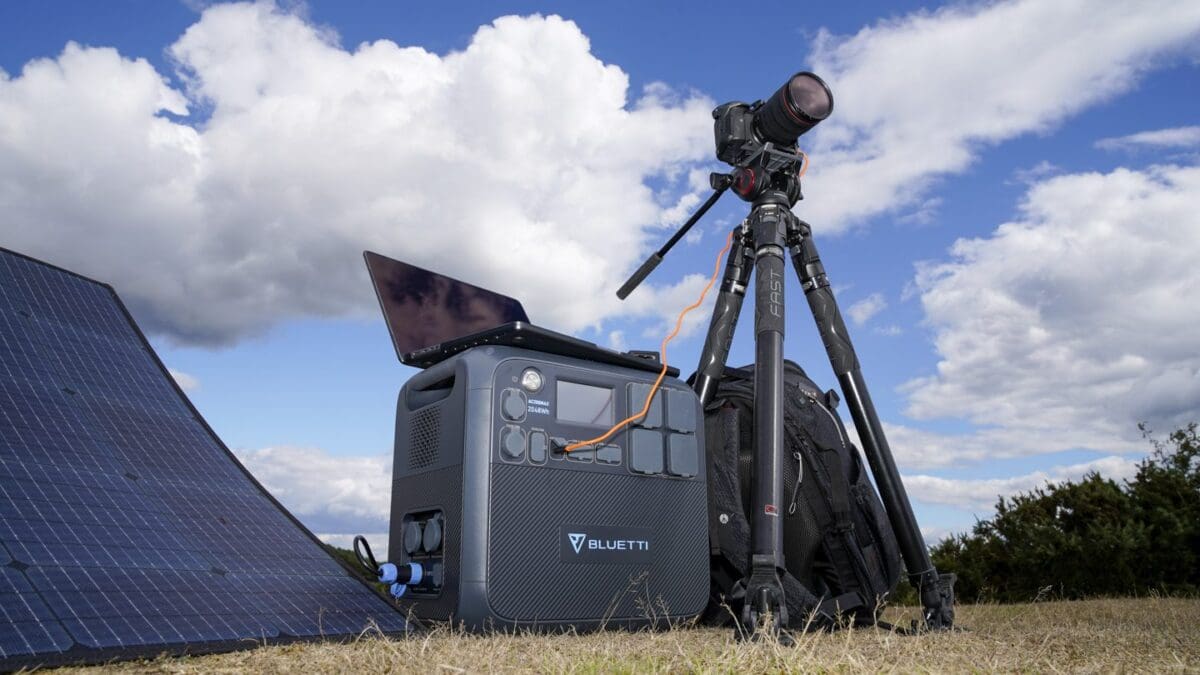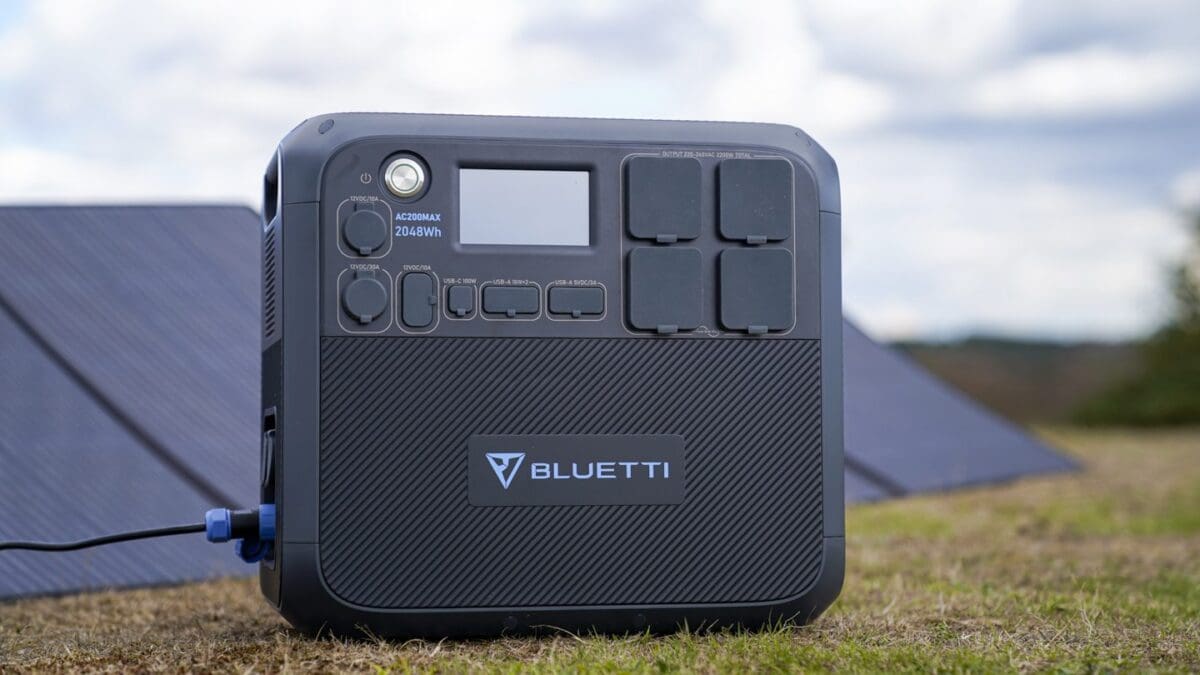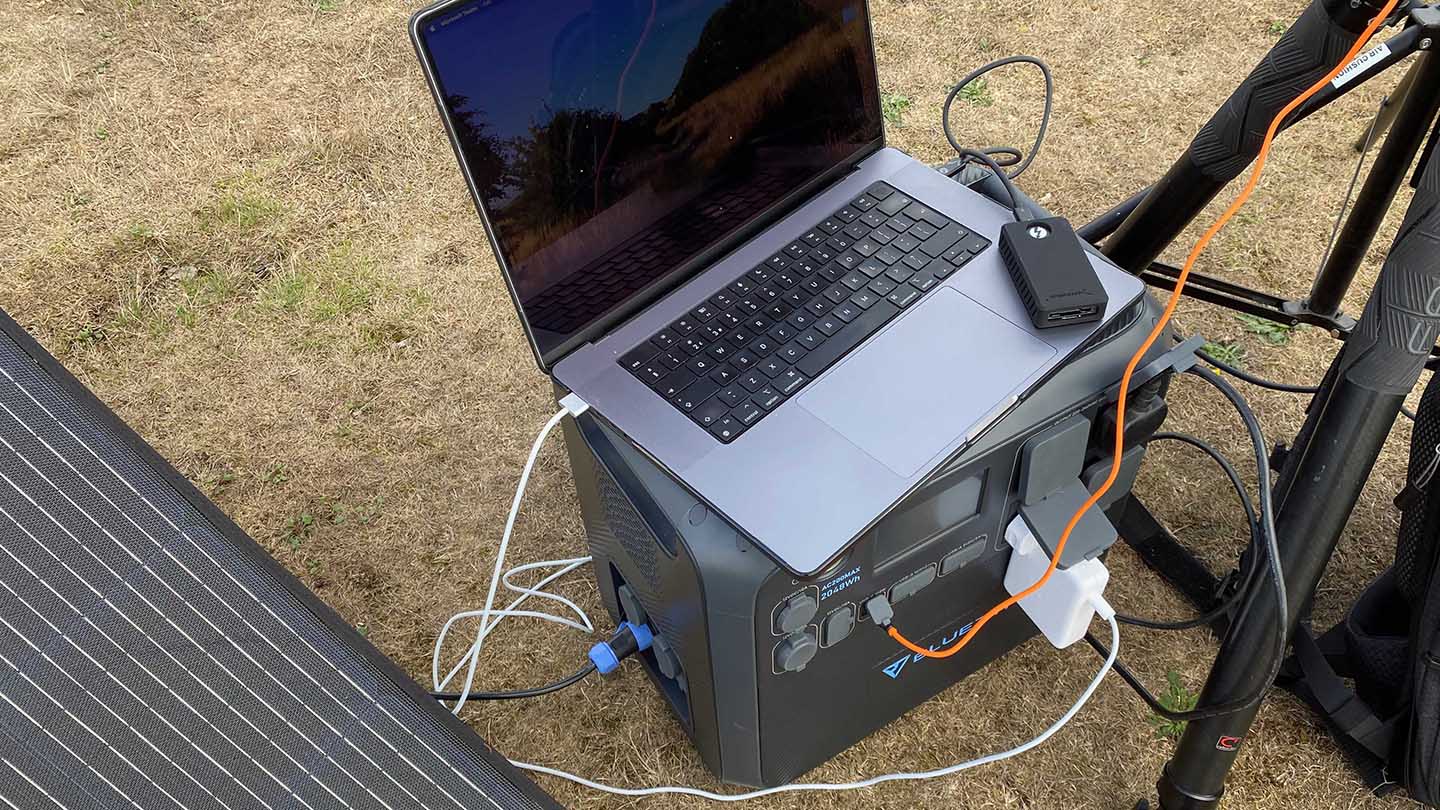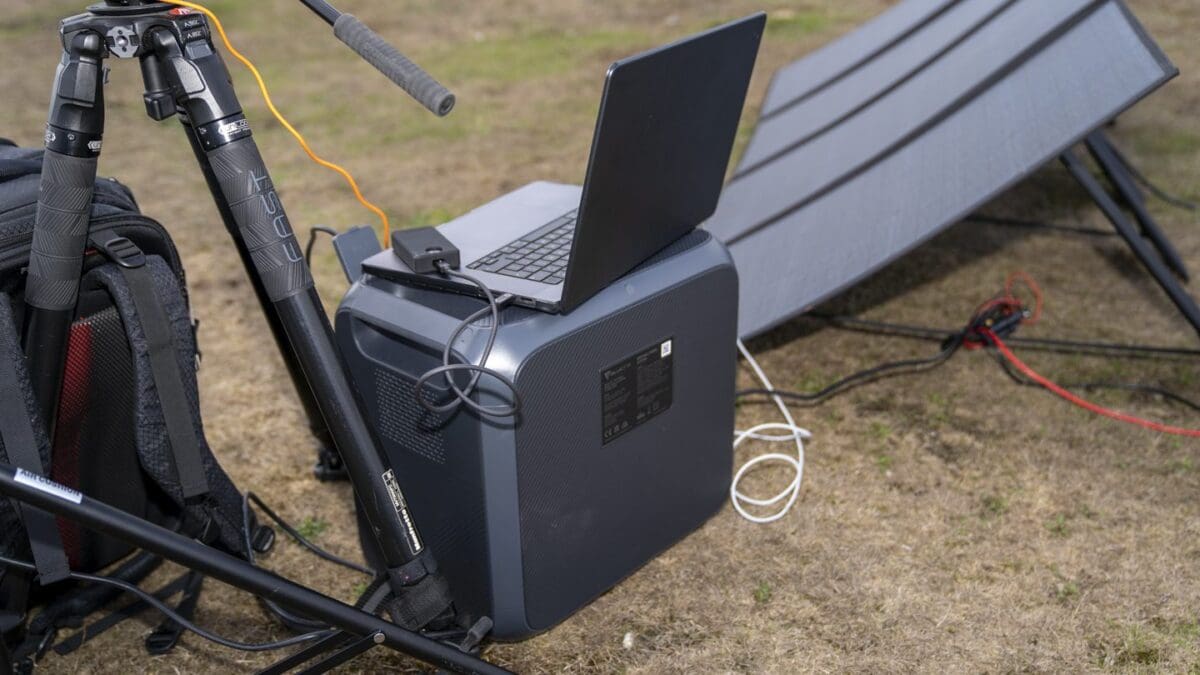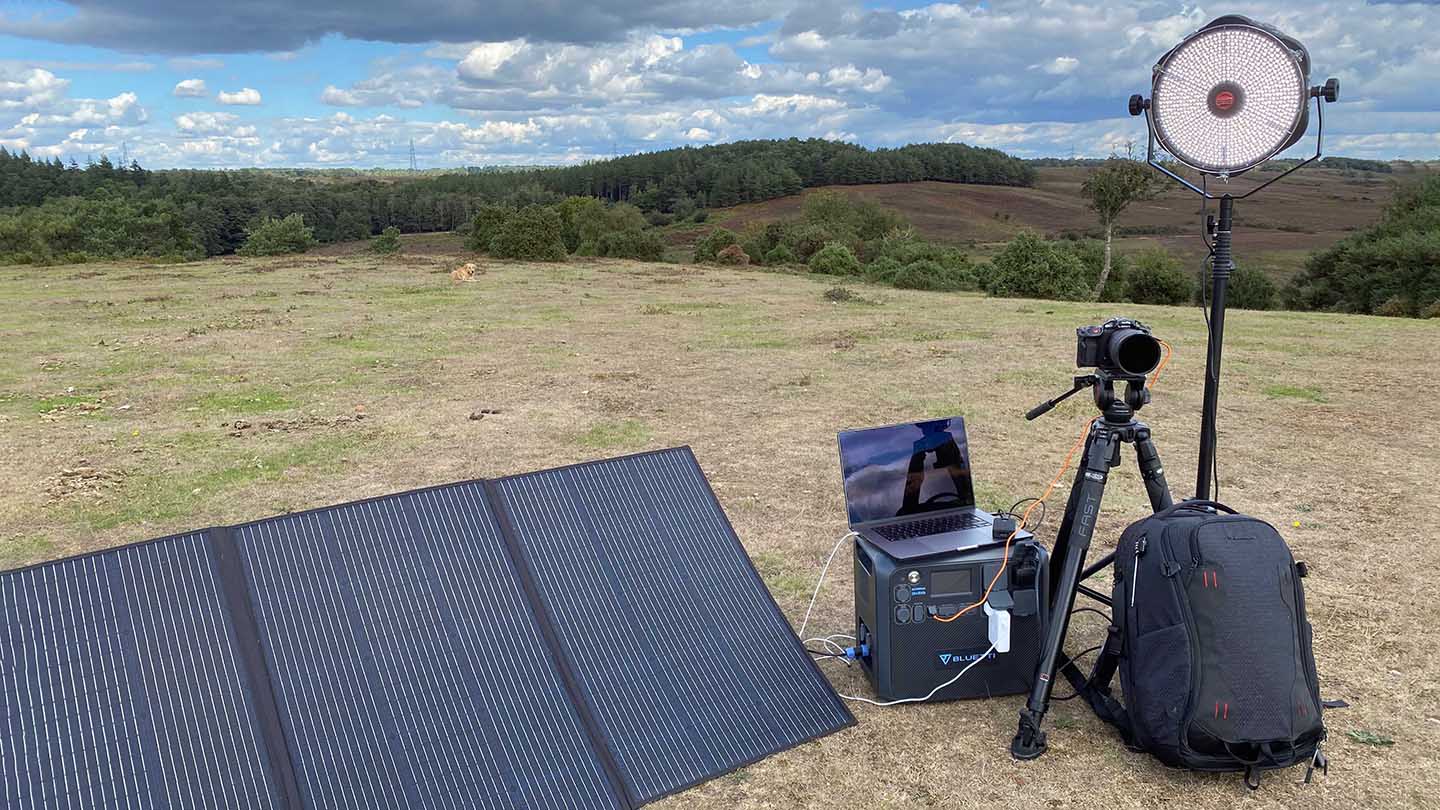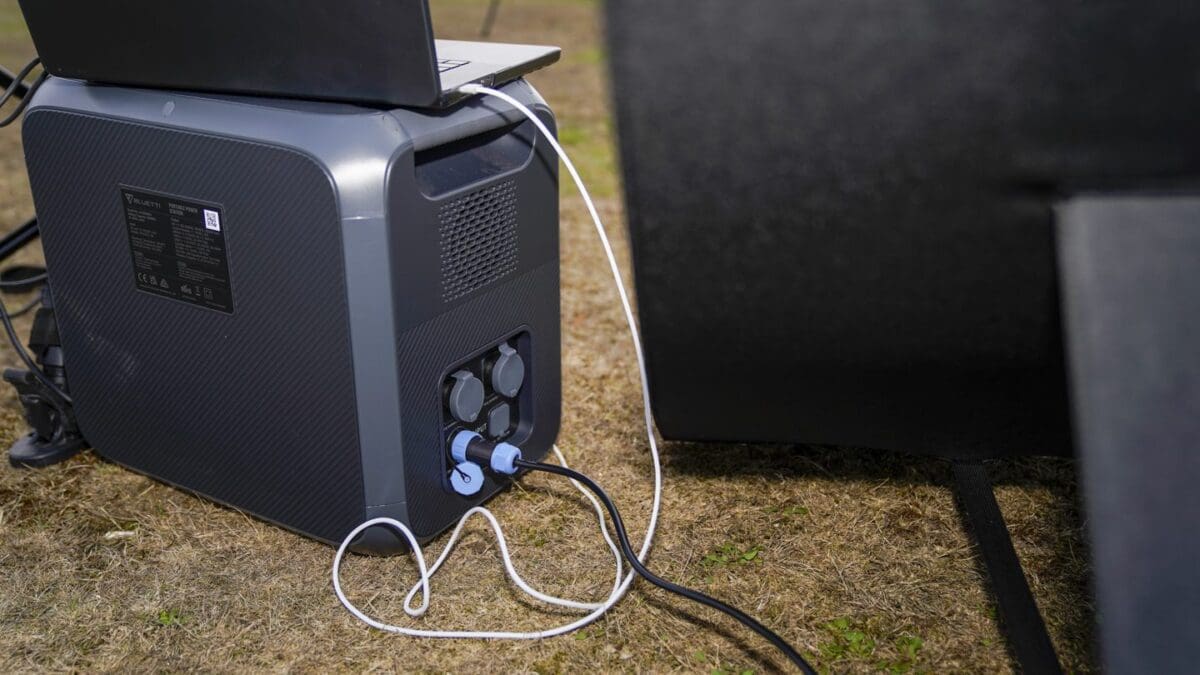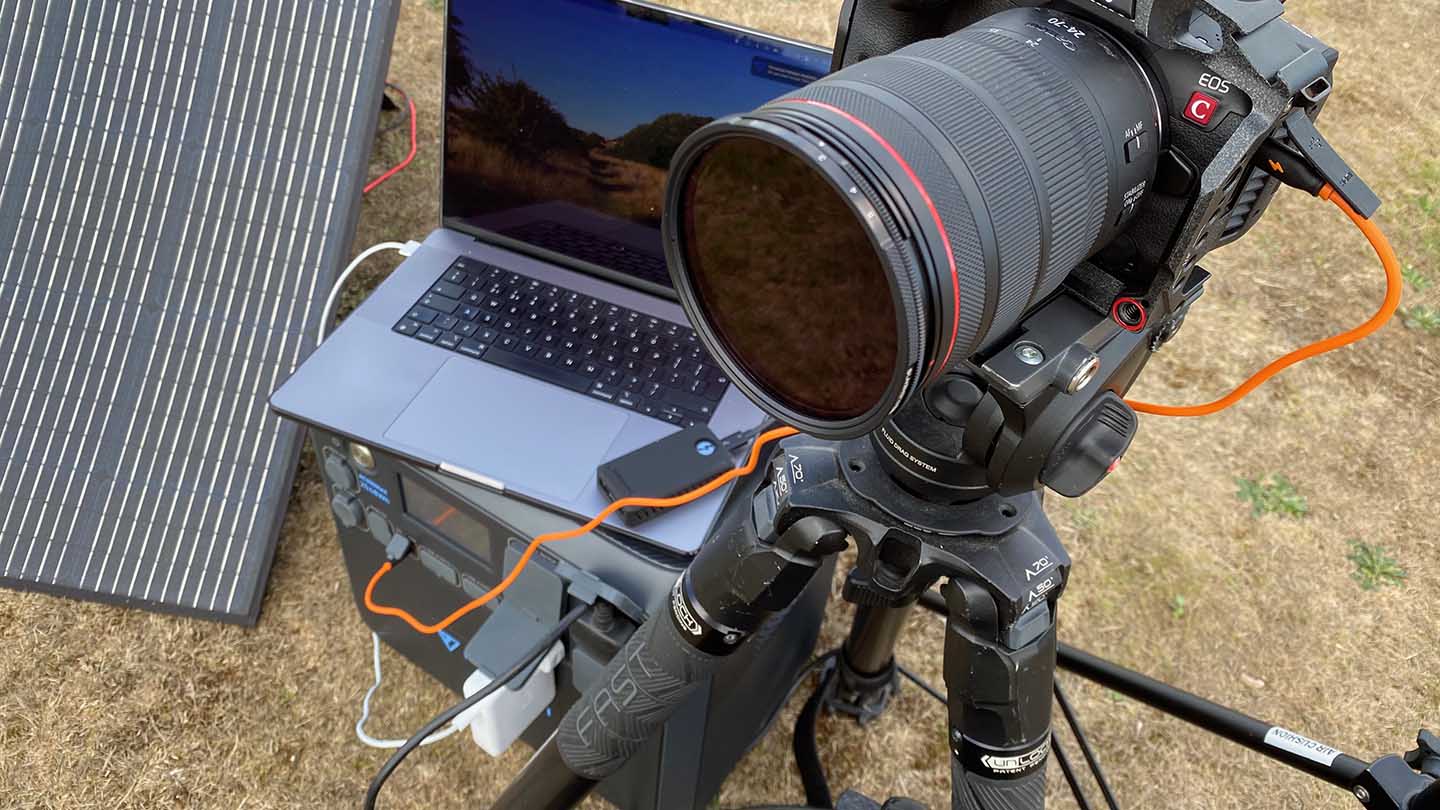In this test, I split the use use of the BLUETTI AC200 Max three ways; the first to see how long it would take to charge through pure solar and then the AC, then to check it out in use as a portable power option and finally as an off-grid power source for the home studio. Using the AC adapter, the AC200 Max was fully charged in around 6 hours from very low; you shouldn’t run the station down to 0% for battery health reasons, but it was close. After fully draining the power station again, it was time to test the charge times using the PV350 panel.
The PV350 solar panel is huge and weighty but well-designed, and a systematic approach to unfolding and putting down the legs makes the set-up of the panel one of the easiest on the market. The cable that connects the panel to the power station is of a decent length and utilises standard MC4 connectors to adapt to the power adapter required by the AC200 Max. This screw-in connector is a little cheap and weak compared with the rest of the design, so it’s well worth ensuring that it’s in place and tightened correctly from the outset to avoid mishaps.
Once connected, the panels instantly kick into life, with 50w being produced without effort in the shade and going up to 300w in the bright late summer sun. In total, it took between 10 and 14 hours for the power station to hit 100%. During the summer’s height, I think you’d get a full charge in less than nine hours and in the UK winter a week! However, the potential to plug the unit into a permanent solar array opens up the use and potential of the AC200 Max power station.
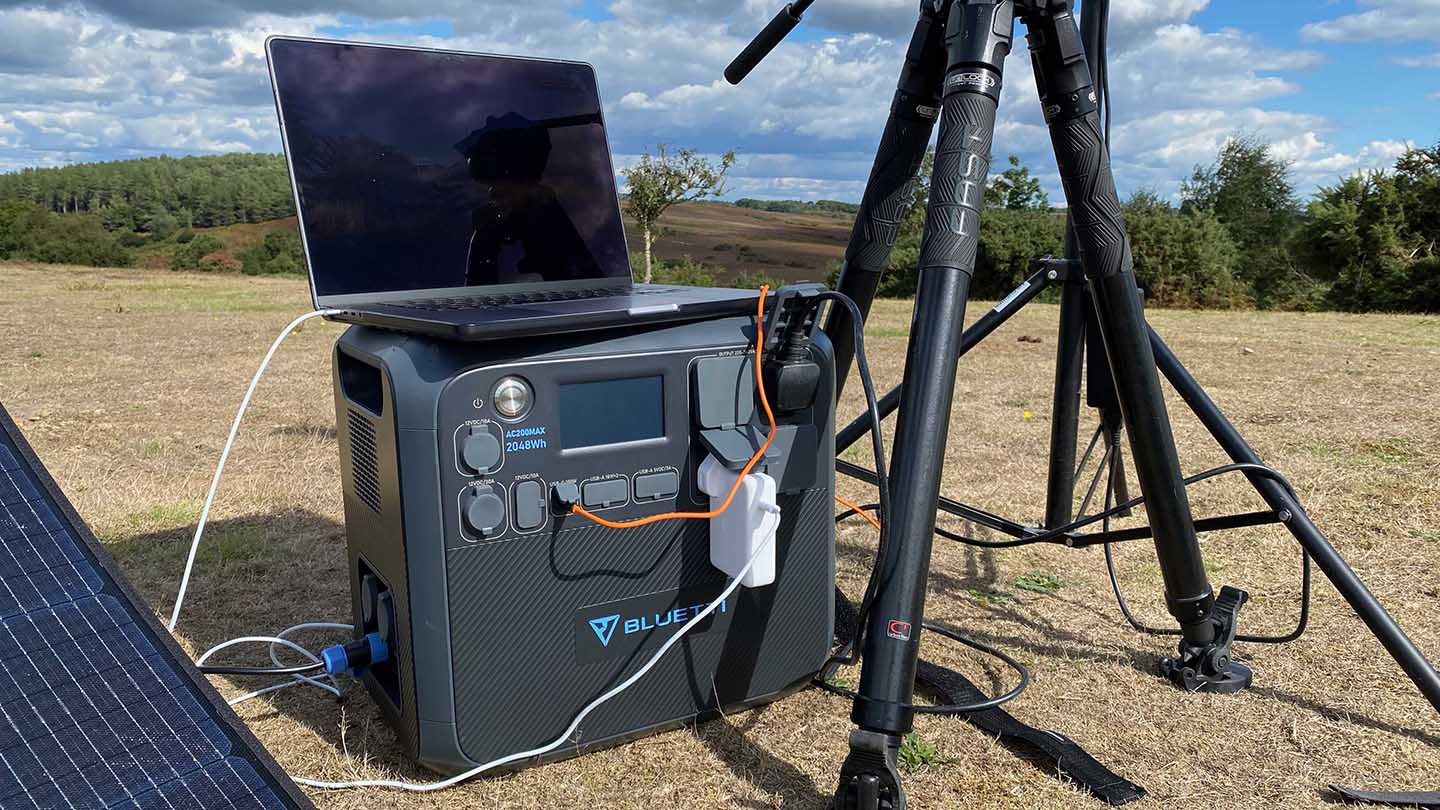
Ultimately however you decide to charge the AC200 Max, it’s simple. Through the mains, it’s a no-brainer; plug it in, and you’re done until it’s at 100%. When it comes to solar, you just have to wait and shift the panels around the garden as the sun changes position. Living in a house with a south-facing garden helps!
At the end of the first part of the test, the multiple options for charging gave this power station a huge advantage. I found that plugging the AC200 Max into the cigarette lighter port in the car when driving to a destination pumped in around 100-150w of power; then, the Solar enabled me to charge whilst I was busy with the shoot. If stopping overnight, the AC200 Max could be smuggled into the B&B and plugged in or linked into the power hook-up on campsites.
However, as the weight of the AC200 Max is around 30kg, lugging this and the rest of the kit isn’t an option, especially if stairs are involved.
When camping, lifting isn’t an issue. The AC200 Max also doubles quite nicely as a stool, although after several weeks of using it for this purpose, it has started to creek a little when I sit down, so maybe not the best idea!
Used as an in-the-field power source
The next test was to see how it performed in a portable studio. For this, I used the following kit, 1 x MacBook Pro (100w), 1 X BenQ BL2711U monitor (50w), RotoLight ANOVA x 2 (72w), Canon EOS R5 C (10w) chargers x 3 (50w), phones and other kit (50w) the total worked out at about 500w an hour. Lights and camera are of course not running for all that time so that amount does vary. The fully charged AC200 Max in ideal conditions provide 4.3 hours of use if everything ran at full capacity.
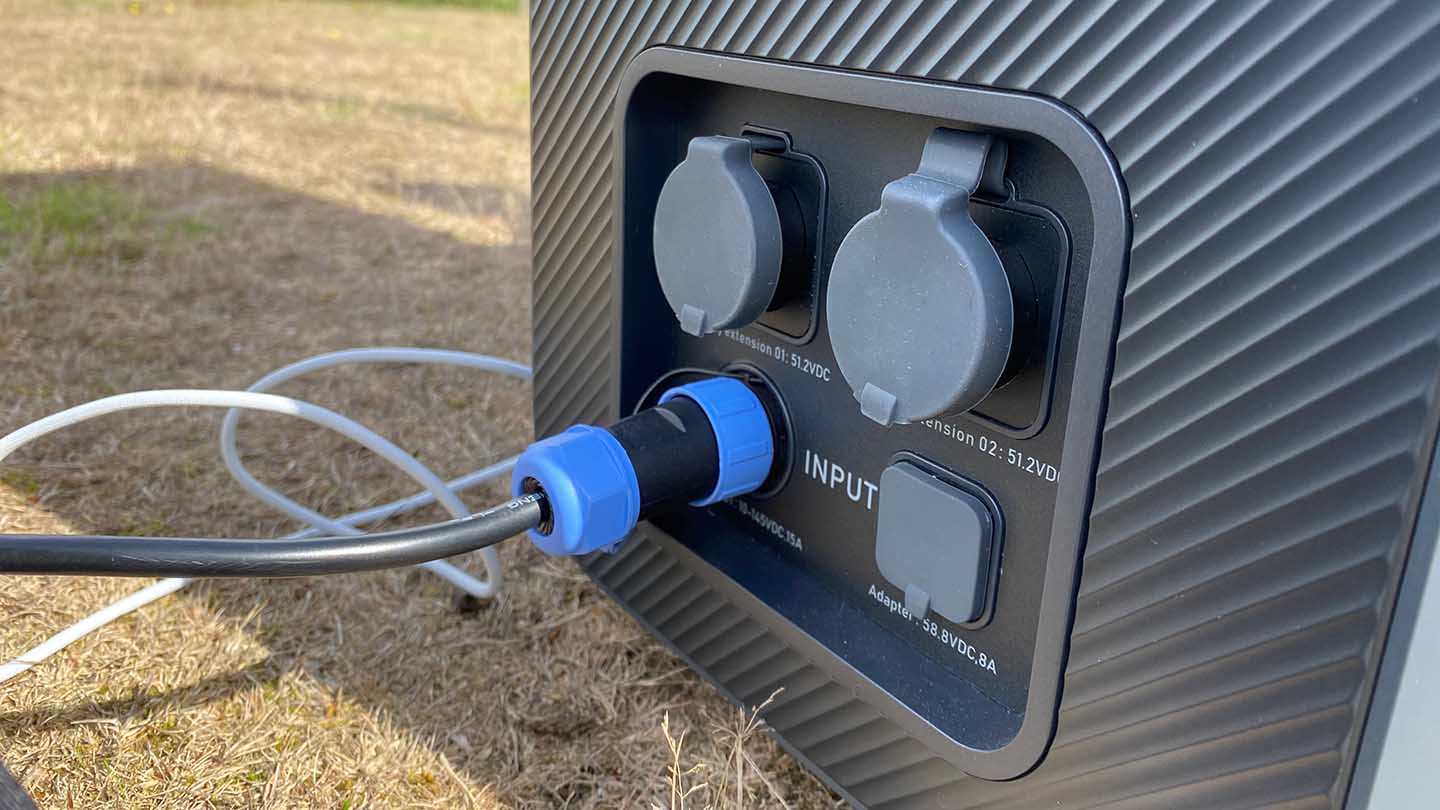
However, in a more real-world scenario but still trying to max out the use with a shoot that started at 8 am and finished at 3 pm, the AC200 Max made it through the day with 5% left in the bank. This test was essentially maxing out the AC200 Max without relying on the internal or V-Lock batteries from the lights or cameras.
Repeating the test in a more real-world use with the Solar panel set up and connected, the AC200 Max stayed topped up for most of the day. The 350w panel provided a near-constant 300w of power input which retained an 80-100% charge for the day, leaving plenty of power for the evening.
Throughout the day, the main AC ports worked as they would with the mains, the only issue being that the rubber socket covers were a little fiddly, and some adapters wouldn’t plug in due to the design of the flaps. In the end, it was far easier to use an extension cable, and the AC200 Max has more than enough juice to enable this.
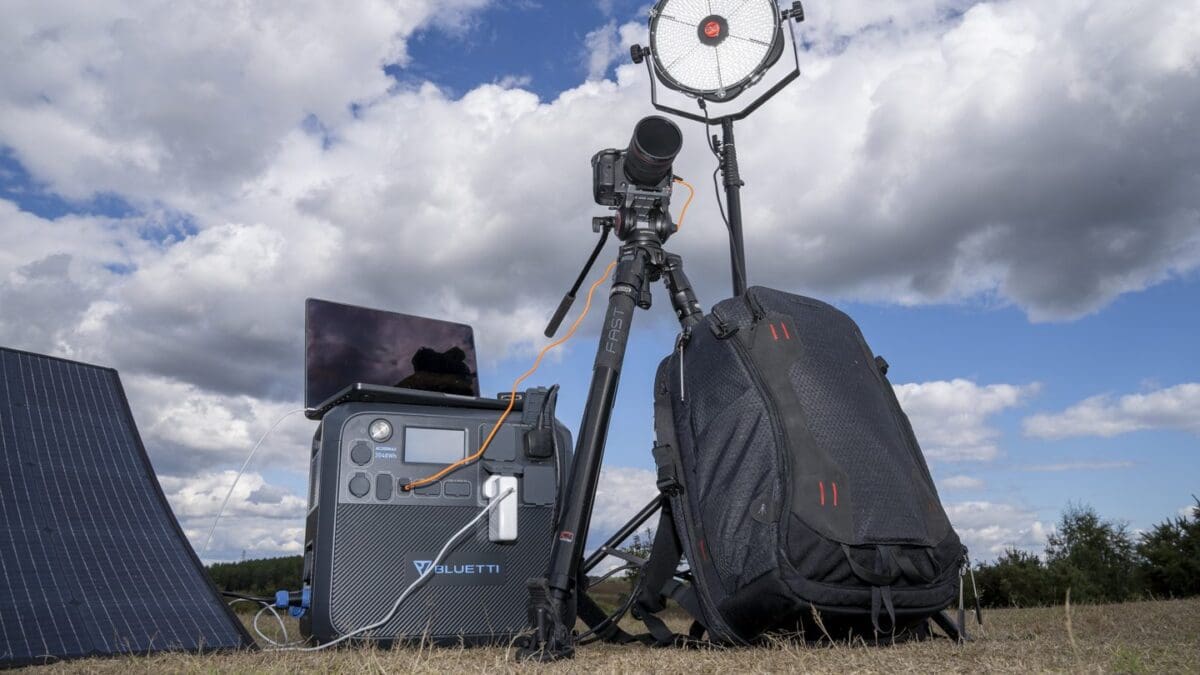
The USB ports were all well-positioned and easy to access, and using a spare MacBook Pro USB Type-C power cable, I could plug the Canon EOS R5 C directly into the AC200 Max to utilise PD power.
The only real issue is the noise of the fans. When recording audio, I had to switch off the AC200 Max as the fans under load became noticeable. However, using the extension lead in the later test and utilising the built-in power supplies for the camera and lights did mean that the AC200 Max could be moved out of hearing distance when needed.
Off-grid studio
I’ll be going more in-depth into the off-grid photo studio in a separate article soon, as there’s plenty of interest in this area of power supply area at the moment; however, covering it fully in the review would be a little limiting. The AC200 Max is a great option for going off-grid, with a built-in inverter and maximum power output of 2200w with a 4800w surge. While these specs won’t enable you to use everything you can on mains electricity power, it does enable about 90% of appliances and devices.
Simple off-grid power supply
This test sees the Power Station being used as an off-grid power supply. The AC200 Max was charged through solar for roughly two days, and, once fully topped up placed in the corner of the studio with lots of items plugged into it; computer, camera chargers etc. Once drained, its lugging back outside, plugging into the PV350 solar panel to charge before repeating the process. The whole process is labour intensive but rewarding as you start to see your electricity bill fall, also the ability to move your workstation outside and really to anywhere you want. However, setting up the solar panels every day is a little time consuming.
The other option is to do something a little more drastic: purchase some solar panels that match the spec that’s compatible with the AC200 Max, drill a hole in the roof, feed a cable through and plug the third-party solar panels into the AC200 Max to see if the system works.
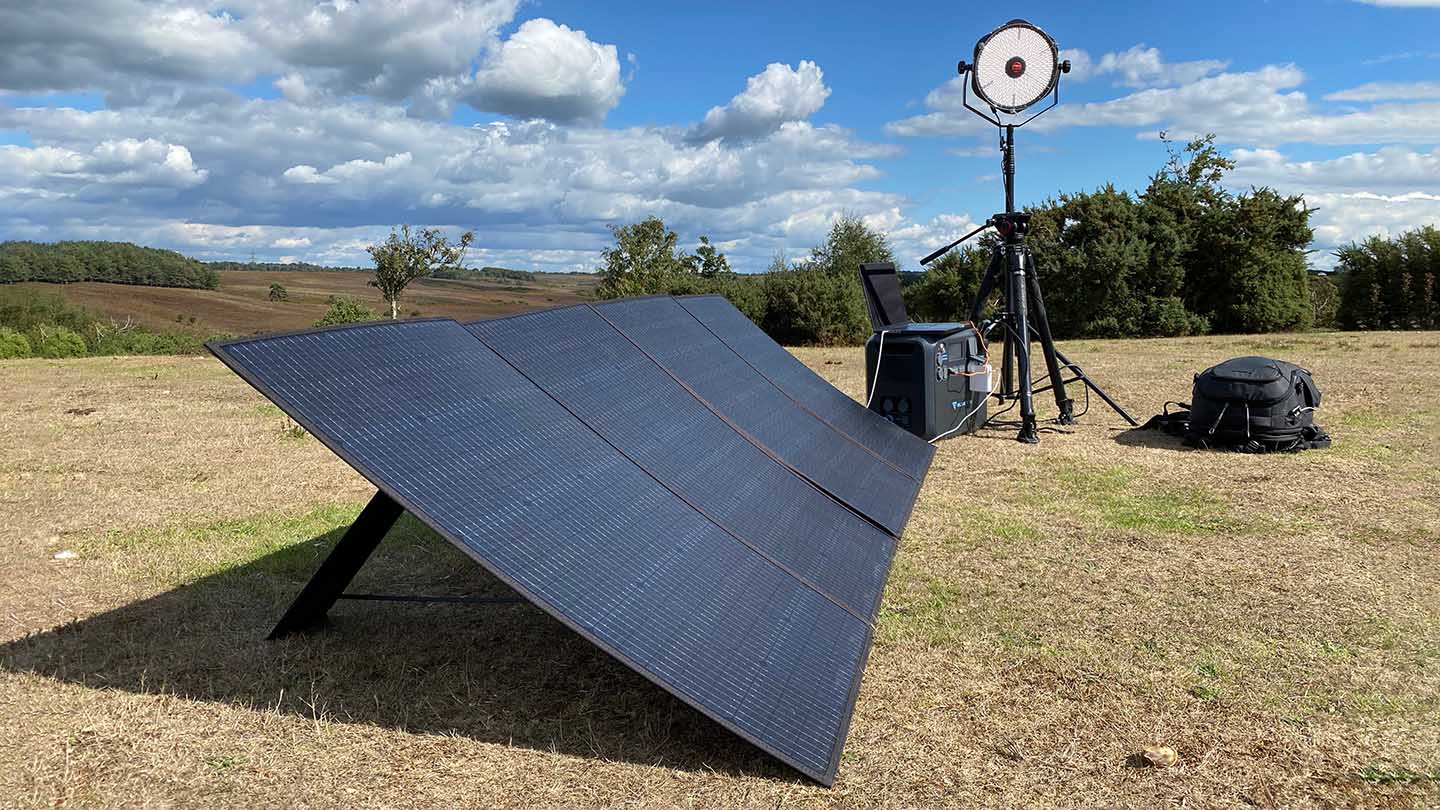
Surprisingly it did, even if the initial construction of the solar panels to the roof and hole were a little messy I’m now in the process of developing something a little more permanent.
Ultimately, two JA Solar 375w panels giving a maximum of 750w of input power enabled the charging of the AC200 Max in around 4 to 5 hours. At the same time, the power from the AC200 Max can power the lights and MacPros in the studio along with a 1000w heater.
The 2200w max power draw, when switching to a home rather than a portable studio, takes a little juggling. After a week of unplugging some devices to plug in others, a switch of lighting types etc., you realise that the AC300 or AC500 with expansion batteries is probably the best way to go due to the additional headroom you have on output power draw. This is especially relevant if you need to iron backdrops or covers, as this instantly sets off the overload alarm.
However, for everyday use, in smaller studios, the 2200w output should cover your needs with ample left over. If you’re running a vintage stereo, monitor speakers, dual monitors, Wifi network and two to three machines, you’ll start to push the system’s capabilities, but it will still cope.
What is amazing is how this small system affects your power use. Firstly, how you work and use your kit starts to adapt; you become more focused on how much power is being drawn; the garage fridge, for example, is no more. With the permanent solar panels linked, this gives you more than enough power to happily work through the daylight hours and with the storaged power in the BLUETTI AC200 Max you have a good amount of power that will see you into the night before the power goes down.
There are also energy saving steps to prolong the power of the AC200 Max, such as making sure that you switch off monitors, use the power-saving features of your machines and switch off lights. An additional battery such as the B300 would certainly expand what would be possible with the AC200 Max.
The AC200 Max is an excellent place to start as the first step to an off-grid studio.


